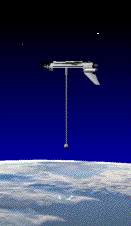| At this moment the only means of transporting payload safely back to Earth, are the United States' Space Shuttle (STS) and the Russian Soyuz. But for the return of payloads back to Earth no European means are available, and the Space Shuttle's capability to bring down payload is limited, because the operational frequency of its mission is planned to be regularly 4 times per year. This leaves the demand for a new type of vehicle to return payload between scheduled Shuttle visits. |
|
I have been working on this project until mid 2004, and my task consisted on the co-ordination of the whole project and the tasks of the students, universities, and a couple of industrial firms taking part on it. |
| The re-entry vehicle
|
| Also, in order to increase the safety, in the case of the
inflatable structure failing to inflate during re-entry, the structure
is such that it will burn up harmlessly in the atmosphere.
|
| The Tether
|
| The tether system is directed by the gradient of the force of the gravity in the way that it is deployed by itself and that the tension is maintained once deployed. When two masses are connected by a tether in space, they are forced to orbit the Earth at equal angular velocities by the tension of the tether itself. In the other hand, orbit dynamics for ordinary satellites states that those objects in a lower circular orbit will rotate around the Earth at higher velocity than those situated at higher altitudes. |
 |
When the tether is cut, the mass in the lower orbit (the re-entry
capsule in our case) will no longer receive tension from the tether,
and it will remain in orbit with a velocity too low to maintain a circular
trajectory. The capsule will then enter into an elliptic orbit, with a
perigee lower than its initial circular altitude (about 7 times the length
of the
tether). If this new perigee is situated inside of the Earth
atmosphere a re-entry will commence. In the same way, the upper mass (the
International Space Station in our case) will be inserted into a higher
orbit.
Taking in account that, because of the orbit at which is situated the Space Station "falls" 200 meters per day, which means that it has to be "re-boosted" regularly, it is obvious that the regular use of this method would save fuel and energy. The whole vehicle and the tether system will be tested from a Russian Foton satellite, installed on the top of the battery module. The launch has been fixed for 2004. |
| Iñaki Rodriguez Rebolledo |
|
Curriculum Vitae, 2004 |